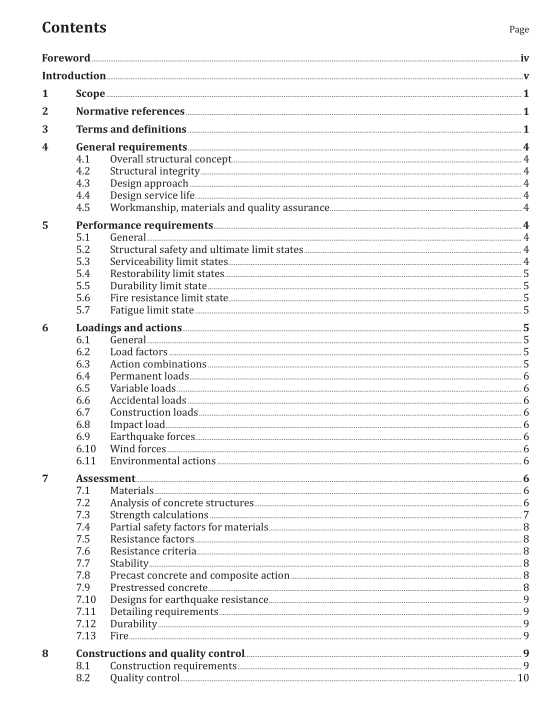BS ISO 19338:2014 pdf download.Performance and assessment requirements for design standards on structural concrete
4 General requirements
4.1 Overall structural concept
The overall quality of a structure shall be implemented through strict quality control and care by a knowledgeable qualified design professional complying with ISO 2394. ISO 6241. and ISO 7162. In conceiving a structural system, load-carrying behaviour under maximum and frequent loads, materials and their combinations, constructihility, costs, and environmental aspects and aesthetics shall be considered.
4.2 Structural integrity
Design of concrete structures shall provide general structural integrity, directly or implicitly. Localized damage or deterioration In a structure shall not impair general structural integrity.
4.3 Design approach
A design standard for structural concrete shall be based on quantitative performance evaluation at the limit states. Design shall consider safety, serviceability, restorability, structural Integrity, robustness, environmental adequacy, and durability, Where applicable, limit states caused by fatigue, tire, explosion, impact, and rare accidental actions or other extreme loadings or actions shall be considered.
4.4 Design service life
Design service life shall be defined in consideration of the structural role, the social importance of the structures concerned, and the economically justitied service life. Structural requirements shall he satisfied throughout the defined design life.
4.5 WorkmanshIp, materials and quality assurance
In order for the properties of the completed structure to he consistent with the requirements and the assumptions made during the planning and design, quality assurance and execution expectations for construction shall be considered and adequate quality control measures shall be taken.
S Performance requirements
5.1 General
For limit states, the design standard shall specify sets of action combinations and a reliability-based design concept that can be analytically demonstrated to give an adequate performance level during the design life of the structure.
5.2 Structural safety and ultimate limit states
The safety level shall be selected considering the consequences of failure, the inability of the facility to fulfill its function, the relative importance of the expected modes of failure, the redundancy of the structure, and the ability to inspect and maintain the finished structure during service. Compressive stresses in concrete under any loads, including sustained loads, shall not cause crushing of the concrete.
5.3 Serviceability limit states
5.3.1 General
Service load deflections, vibrations, and cracking shall be limited so that they do not impair the use of the structure. Serviceability limit states shall be considered using factored loads and load combinations
in which the load factors correspond to an acceptable probability of occurrence of the serviceability limit slate being checked.
5.3.2 VIbration until state
Dynamic response and/or periods of vibration of a structure shall be considered and limited to avoid discomfort to occupants, Impairing use of the structure, and/or avoid the risk of resonance. Dynamic analyses shall be used where required.
5.4 Restorability limit states
Damages in structures caused by loadings and actions, such as earthquake forces and environmental actions, shall be limited so that the maintenance and repair works could be conducted by an economically and technically feasihle way. Restorahility shall he considered using factored loads and action combinations in which the load factors correspond to an acceptable probability of occurrence of the restorability limit state being checked,
5.5 Durability limit state
The structure shall be designed such that deterioration does not cause it to reach an ultimate limit state, a serviceability limit state, a restorability limit state, or a fatigue limit state during its design life. Regular maintenance shall be prescribed (In the standard or through reference to an international. national, or regional standard) and considered In determining the design service life of a structure.
5.6 Fire resistance limit state
When exposure to fire during the life of a structure is possible, the structural concrete can provide adequate lire resistance with regard to life safety and residual structural capacity during and after a fire.
5.7 FatIgue limit state
For structures or parts of structures where fatigue may be a limiting design consideration, the fatigue limit state shall be considered. Where fatigue is considered, performance requirements under fatigue loading shall be specified.
6 LoadIngs and actions
6.1 General
Loads due to use and occupancy arid environmental actions shall be defined considering excess probability or recurrence Interval based on statistically surveyed data.
6.2 Load factors
Load factors In general conformance with reliability-based design concept shall differentiate between the different variabilities olpermanent loads, frequent variable loads due to use and occupancy, frequent environmental actions, and rare loads. Load factors shall also differentiate between stabilizing and unstahilizing loads.
6.3 ActIon combinations
Action combinations used shall recognize the reduced probability of the simultaneous occurrence nt variable loads.BS ISO 19338 pdf download.ISO 19338-2014 pdf download
